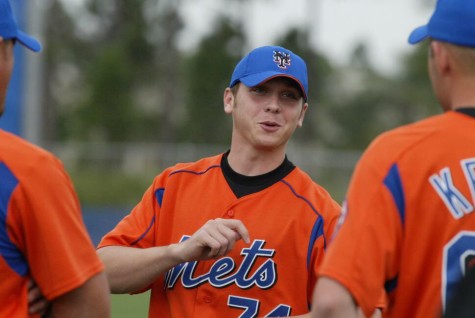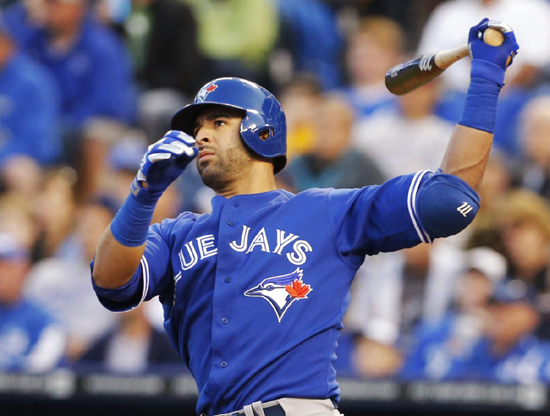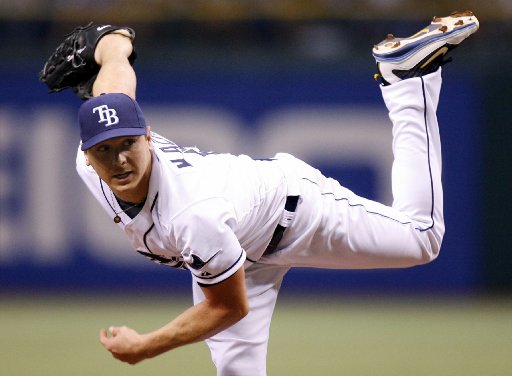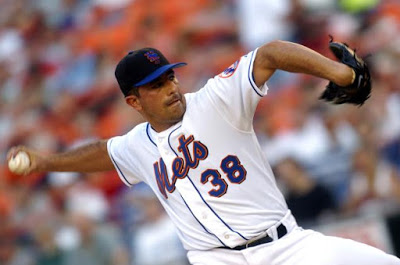
Every sports team can look back at decisions made in their franchise history that they later regretted. After all, hindsight is 20/20. However, these decisions still bring back a sense of pain and beg the question of “What could have been?” The New York Mets are no strangers to these types of regrettable decisions and have been notorious throughout baseball for many of them. One such example is LHP Scott Kazmir.
Kazmir’s Days Within The Mets Organization
The Mets drafted Kazmir in the first round (15th overall) of the 2002 MLB Draft out of Cypress Falls High School in Houston, TX. Prior to the draft, Kazmir was described as an ordinary kid with extraordinary talent.
“In many ways No. 19 is a typical high schooler — a lean, clean-cut teen with broad shoulders who looks like the neighbor kid you hired to mow your lawn,” wrote Jim Molony of MLB.com. “But the word typical does not apply when the conversation turns to this exceptional left-hander’s ability to pitch a baseball. His name is Scott Kazmir, and when next month’s First-Year Player Draft rolls around this extraordinary southpaw could be the very first high school pitcher selected.”
Kazmir ended up being the fifth high school pitcher selected in the draft. The southpaw was picked after RHP Chris Gruler (drafted third overall by the Cincinnati Reds), LHP Adam Loewen (drafted fourth overall by the Baltimore Orioles), his high school teammate Clint Everts (drafted fifth overall by the Montreal Expos) and Zack Greinke (drafted sixth overall by the Kansas City Royals).
Although Greinke turned out to be the best high school pitcher from the draft by far, Gruler and Everts never ended up making the majors and Loewen struggled across parts of five MLB seasons.
Kazmir arrived to New York and quickly established himself as a top prospect throughout baseball. In five starts and 18 innings with the Brooklyn Cyclones in 2002, the 18-year-old Kazmir struck out 34 batters and allowed only one earned run (0.50 ERA). Baseball America ranked him as the 11th best prospect in baseball coming into the 2003 season.
In his first full minor league season in 2003, Kazmir continued to showcase his dominant strikeout rate. The 19-year-old struck out 145 batters in 109 1/3 innings (11.9 strikeouts per nine innings) between the Capital City Bombers and St. Lucie Mets. He also finished the 2003 campaign with a 2.63 ERA and 1.125 WHIP.
Heading into 2004, Kazmir was still high in the prospect rankings as Baseball America ranked him the 12th best prospect in the game. While he started the year in St. Lucie, he continued his quick ascent through the Mets minor league system as he received a promotion on July 10, 2004 to the Binghamton Mets.
Double-A did not slow down Kazmir. In his first four starts for Binghamton, the 20-year-old put up a 1.73 ERA, a 0.962 WHIP and 29 strikeouts in 26 innings. However, beginning in August Kazmir’s ascent through the minors would go through the Tampa Bay Devil Rays organization.

A Day Of Trades
The day was July 30, 2004, and the Mets fell to 49-53 on the season and seven games out of a playoff spot after losing to the first-place Atlanta Braves by a score of 3-1. However, that was not the biggest news of the day as earlier in the day, the Mets were involved in three trades with three other teams.
In one deal, the Mets traded C Justin Huber to the Royals in exchange for 3B Jose Bautista. In another deal the Mets flipped Bautista in addition to 3B Ty Wigginton and RHP Matt Peterson to the Pittsburgh Pirates in exchange for RHP Kris Benson and INF Jeff Keppinger. In the third deal the Mets traded Kazmir and RHP Jose Diaz to the Tampa Bay Devil Rays in exchange for RHP Victor Zambrano and RHP Bartolome Fortunato.
While Bautista would go on to be a six-time All-Star and three-time Silver Slugger, at the time he struggled to stick with a team. The Mets were his fifth different team (albeit for less than a day) in less than a year before he stuck with the Toronto Blue Jays and found a great deal of success. So while losing out on the future of Bautista may involve a level of regret, it was hard to blame the Mets for the Bautista deal as much as the Kazmir deal.
In regards to Kazmir, the Mets gave up on a top prospect and quickly rising star in their organization for a couple of pitchers who were basically non-factors in the team’s pursuit for success.
While widely looked upon as poor in the present, at the time some were happy with the deal.
“Some may believe the Mets mortgaged their future for the present,” wrote Mark Hale of the New York Post on July 31, 2004. “After all, Kazmir and Peterson are their two top pitching prospects. But the Mets’ philosophy is they were willing to trade unproven minor league talent for proven major league talent that is both young and controllable for several years.”
Mets general manager Jim Duquette was thrilled with the deal at the time.
“We felt Zambrano was a guy Kazmir eventually could be,” Duquette said. “But Kazmir is still a ways away.”
Duquette was all-in despite the Mets being three games under .500 and six games out of a playoff spot earlier in the day. He felt the trio of deals would help put the Mets over the top and the reward of the trades would outweigh the risks.
“We’re still in the hunt and we’re still in the mix. Let’s go for it,” Duquette said. “With these guys added to the rotation, we’re going to have a chance to win every night.”

An Ace Is Born In Tampa Bay
Upon his trade to Tampa Bay, Kazmir made four dominant starts for the organization’s Double-A affiliate Montgomery Biscuits before being called up to the majors on Aug. 23, 2004. Despite Duquette saying Kazmir was “still a ways away,” on July 30, the Devils Rays felt the 20-year-old was ready for The Show less than a month later.
Kazmir appeared in eight games and made seven starts during the final stretch of 2004. Although his results were a mixed bag in his first handful of starts, it was a completely different story from 2005 to 2008.
In 2005, Kazmir finished ninth in the American League Rookie of the Year voting. While he struggled with control (as evident by his league-leading 100 walks issued), he had a solid season overall as he went 10-9 with a 3.77 ERA, 1.462 WHIP and 174 strikeouts in 186 innings pitched.
Kazmir took a step forward in 2006 although in only 24 starts. The 22-year-old was selected to his first All-Star game in a season where he went 10-8 with a 3.24 ERA, 1.272 WHIP and 163 strikeouts in 144 2/3 innings.
The 2007 season was when Kazmir reached the apex of his career. The southpaw led the league in strikeouts with 239, and went 13-9 with a 3.48 ERA and 1.379 WHIP in 206 2/3 innings.
In 2008, Kazmir dealt with a strained elbow that delayed his season until May 4, but did not hold him back from another overall successful season. On May 14, he was rewarded for his production by the newly-named Tampa Bay Rays with a four-year, $28.5 million extension. He responded by having another All-Star season that helped carry the Rays to the franchise’s first winning season, first playoff appearance, first and only ALCS appearance and first and only World Series appearance.
After 2008, Kazmir’s career took a turn for the worse. He struggled in 2009 with the Rays and was traded to the Los Angeles Angels. While he found some brief success with the Angels in his six starts with the team in 2009, he experienced the worst season of his career in 2010. The 26-year-old went 9-15 with a 5.94 ERA, 1.580 WHIP and 93 strikeouts in 150 innings.
Kazmir made only one start in 2011 and was pitching for the Sugar Land Skeeters, an independent baseball team, by 2012.
Kazmir experienced a career renaissance from 2013-2016 which resulted in a few more solid seasons and a third All-Star selection. While he has not pitched in a major league game since 2016, the southpaw still seeks a comeback to this day, confirming to Marc Topkin of the Tampa Bay Times at the end of January that he wanted to return to the majors in 2020.
Despite an up-and-down overall career, Kazmir experienced stretches of success that could have helped the Mets had they held onto the southpaw.

What Could Have Been For The Mets
On the flipside you have the post-Kazmir trade Mets.
In 2004 the Mets finished the season with an abysmal 71-91 record and 21 games out of a playoff spot.
Zambrano only pitched 14 innings in 2004 and 25 1/3 innings in 2006. His best season came in 2005 when he went 7-12 with a 4.17 ERA, 1.485 WHIP and 112 strikeouts in 166 1/3 innings.
While Kazmir contributed 16.6 bWAR to Tampa Bay in parts of six seasons, Zambrano contributed 1.7 bWAR to the Mets in parts of three seasons.
Fortunato, on the other hand, made 15 relief appearances for the Mets in 2004 in which he struck out 20 batters in 18 2/3 innings. He pitched to the tune of a 3.86 ERA and 1.446 WHIP in those handful of games.
The reliever then missed all of 2005 due to injury and pitched a total of three innings in 2006 to end his Mets career and major league career.
What really stings in hindsight is thinking how much better Kazmir would have made the Mets at a time when a pitcher of his caliber could have put them over the top.
Does Kazmir bring the 83-79 2005 Mets into the playoffs? Does Kazmir help the 97-65 2006 Mets win the World Series? Does Kazmir help prevent the historic collapses of the 88-74 2007 Mets and 89-73 2008 Mets?
Kazmir was not a once in a lifetime generational pitcher. The Kazmir trade made by the Mets on July 30, 2004 was not quite like the Nolan Ryan trade on Dec. 10, 1971 where they gave up too early on a future Hall of Famer. However, the Kazmir trade caused the Mets to miss out on a pitcher who dominated during a four-year stretch where the Mets were good, but needed a little extra boost. Kazmir was that extra boost, but Mets fans will never truly know what his presence would have resulted in from 2005-2008.















